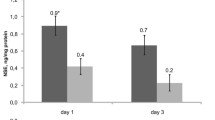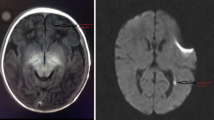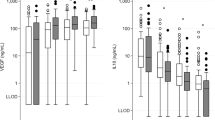Abstract
Neuroprotective interventions in neonatal hypoxic-ischemic encephalopathy (HIE) require early indicators of brain damage to initiate therapy. In order to find a reliable, rapid, and simple method to identify infants at risk for this disorder, 40 infants with asphyxia were selected as the observation group (HIE group) and 25 normal-term infants as the control group. S100β protein concentration and gas analysis of the umbilical cord artery blood of all infants were determined. We found that the S100β protein levels of the HIE group (1.98 µg/L) were higher than those of the control group (1.05 µg/L, p<0.05), and there were significant differences between the mild HIE group (1.72 µg/L) and the moderate or severe HIE groups (3.61 µg/L, p<0.05). An S100β protein concentration cutoff level of 2.02 µg/L had a sensitivity of 86.7% and a specificity of 88.0% for predicting the development of moderate or severe HIE. The blood gas parameters of umbilical artery blood, such as pH, carbon dioxide tension, and base excess, were significantly different in the HIE group compared to the control group (all p<0.001), but there were no differences between the mild HIE group and the moderate or severe HIE groups. On the basis of clinical manifestations of asphyxiated neonates, detecting the S100β protein levels in the umbilical artery blood may be of important value in the early diagnosis and grading of HIE.




Similar content being viewed by others
Abbreviations
- HIE:
-
Hypoxic-ischemic encephalopathy
References
Amer-Wåhlin I, Herbst A, Lindoff C, Thorngren-Jerneck K, Marsál K, Alling C (2001) Brain-specific NSE and S-100 proteins in umbilical blood after normal delivery. Clin Chim Acta 304:57–63
Blennow M, Sävman K, Ilves P, Thoresen M, Rosengren L (2001) Brain-specific proteins in the cerebrospinal fluid of severely asphyxiated newborn infants. Acta Paediatr 90:1171–1175
Committee on Fetus and Newborn, American Academy of Pediatrics and Committee on Obstetric Practice, American College of Obstetricians and Gynecologists (1996) Use and abuse of the Apgar score. Pediatrics 98(1):141–142
Gazzolo D, Grutzfeld D, Michetti F, Toesca A, Lituania M, Bruschettini M, Dobrzanska A, Bruschettini P (2004) Increased S100B in cerebrospinal fluid of infants with bacterial meningitis: relationship to brain damage and routine cerebrospinal fluid findings. Clin Chem 50:941–944
Gazzolo D, Marinoni E, Di Iorio R, Bruschettini M, Kornacka M, Lituania M, Majewska U, Serra G, Michetti F (2004) Urinary S100B protein measurements: a tool for the early identification of hypoxic-ischemic encephalopathy in asphyxiated full-term infants. Crit Care Med 32(1):131–136
Gazzolo D, Vinesi P, Geloso MC, Marcelletti C, Iorio FS, Cipriani A, Marianeschi SM, Michetti F (1998) S100 blood concentrations in children subjected to cardiopulmonary by-pass. Clin Chem 44:1058–1060
Gazzolo D, Vinesi P, Marinoni E, Di Iorio R, Marras M, Lituania M, Bruschettini PL, Michetti F (2000) S100B protein concentrations in cord blood: correlations with gestational age in term and preterm deliveries. Clin Chem 46:998–1000
Gjerris AC, Stær-Jensen J, Jørgensen JS, Bergholt T, Nickelsen C (2007) Umbilical cord blood lactate: a valuable tool in the assessment of fetal metabolic acidosis. Eur J Obstet Gynecol Reprod Biol Nov 30 [Epub ahead of print]
Gordon A, Johnson JWC (1985) Value of umbilical blood acid-base studies in fetal assessment. J Reprod Med 30:329–336
Gururaj A, Sztriha L, Dawodu A, Nath KR, Varady E, Nork M, Haas D (2002) CT and MR patterns of hypoxic ischemic brain damage following perinatal asphyxia. J Trop Pediatr 48(1):5–9
Hårdemark HG, Ericsson N, Kotwica Z, Rundström G, Mendel-Hartvig I, Olsson Y, Påhlman S, Persson L (1989) S-100 protein and neuron-specific enolase in CSF after experimental traumatic or focal ischemic brain damage. J Neurosurg 71:727–731
Horn M, Schlote W (1992) Delayed neuronal death and delayed neuronal recovery in the human brain following global ischemia. Acta Neuropathol 85:79–87
Huang CC, Wang ST, Chang YC, Lin KP, Wu PL (1999) Measurement of the urinary lactate:creatinine ratio for the early identification of newborn infants at risk for hypoxic-ischemic encephalopathy. N Engl J Med 341:328–335
Isobe T, Takahashi K, Okuyama T (1984) S100a0 (alpha alpha) protein is present in neurons of the central and peripheral nervous system. J Neurochem 43:1494–1496
Lorek A, Takei Y, Cady EB, Wyatt JS, Penrice J, Edwards AD, Peebles D, Wylezinska M, Owen-Reece H, Kirkbride V, Cooper CE, Aldridge RF, Roth SC, Brown G, Delpy DT, Reynolds EOR (1994) Delayed (“secondary”) cerebral energy failure after acute hypoxia-ischemia in the newborn piglet: continuous 48-hour studies by phosphorus magnetic resonance spectroscopy. Pediatr Res 36:699–706
Michetti F, Massaro A, Russo G, Rigon G (1980) The S100 antigen in cerebrospinal fluid as a possible index of cell injury in the nervous system. J Neurol Sci 44:731–743
Nagdyman N, Kömen W, Ko HK, Müller C, Obladen M (2001) Early biochemical indicators of hypoxic-ischemic encephalopathy after birth asphyxia. Pediatr Res 49:502–506
Neonatology Branch of Chinese Medical Association (1997) Diagnosis evidences and clinical grades of neonatal hypoxic-ischemic encephalopathy. Chin J Pediatr 35(2):99–101
Perlman JM, Tack ED (1988) Renal injury in the asphyxiated newborn infant: relationship to neurologic outcome. J Pediatr 113:875–879
Persson L, Hårdemark HG, Gustafsson J, Rundström G, Mendel-Hartvig I, Esscher T, Påhlman S (1987) S-100 protein and neuron-specific enolase in cerebrospinal fluid and serum: markers of cell damage in human central nervous system. Stroke 18:911–918
Rothoerl RD, Brawanski A, Woertgen C (2000) S-100B protein serum levels after controlled cortical impact injury in the rat. Acta Neurochir (Wien) 142(2):199–203
Rutherford MA, Azzopardi D, Whitelaw A, Cowan F, Renowden S, Edwards AD, Thoresen M (2005) Mild hypothermia and the distribution of cerebral lesions in neonates with hypoxic-ischemic encephalopathy. Pediatrics 116:1001–1006
Sarnat HB, Sarnat MS (1976) Neonatal encephalopathy following fetal distress. A clinical and electroencephalographic study. Arch Neurol 33:696–705
Shaaban Ali M, Harmer M, Vaughan RS, Dunne J, Latto IP (2000) Early release pattern of S100 protein as a marker of brain damage after warm cardiopulmonary bypass. Anaesthesia 55(8):802–806
Strauss RG (1995) Neonatal anemia: pathophysiology and treatment. Immunol Invest 24:341–351
Vannucci RC, Perlman JM (1997) Interventions for perinatal hypoxic-ischemic encephalopathy. Pediatrics 100:1004–1014
Verdú Pérez A, Falero MP, Arroyos A, Estévez F, Félix V, López Y, Pantoja A, Ureta A (2001) Blood neuronal specific enolase in newborns with perinatal asphyxia. Rev Neurol 32:714–717
Westgren M, Divon M, Horal M, Ingemarsson I, Kublickas M, Shimojo N, Nordström L (1995) Routine measurements of umbilical artery lactate levels in the prediction of perinatal outcome. Am J Obstet Gynecol 173(5):1416–1422
Wirds JW, Duyn AEJ, Geraerts SD, Preijer E, van Diemen-Steenvoorde JAAM, Schagen van Leeuwen JH, Haas FJLM, Gerritsen WBM, de Boer A, Leusink JA (2003) S100 protein content of umbilical cord blood in healthy newborns in relation to mode of delivery. Arch Dis Child Fetal Neonatal Ed 88:F67–F69
Acknowledgments
We thank Dr. Xiang-Ping Xu for her assistance.
Author information
Authors and Affiliations
Corresponding author
Rights and permissions
About this article
Cite this article
Qian, J., Zhou, D. & Wang, YW. Umbilical artery blood S100β protein: a tool for the early identification of neonatal hypoxic-ischemic encephalopathy. Eur J Pediatr 168, 71–77 (2009). https://doi.org/10.1007/s00431-008-0711-4
Received:
Revised:
Accepted:
Published:
Issue Date:
DOI: https://doi.org/10.1007/s00431-008-0711-4




